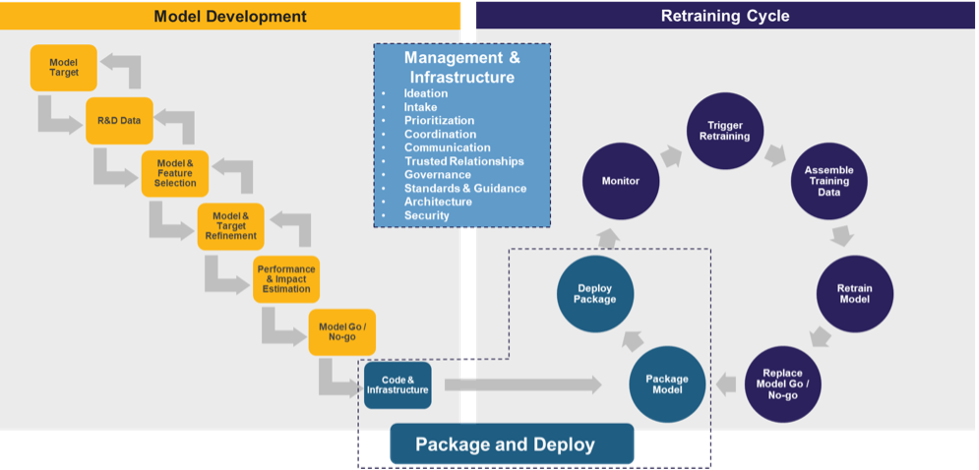This post is to help enhance your understanding of and challenges involved with developing a mature machine learning environment.
You heard machine learning (ML) was the wave of the future. If you didn’t start using it soon, your competitors would be, which would deprive you of opportunities. When you hired smart people and cut them loose on some data, though, it wasn’t enough.
Several months or years in, you are running into all kinds of obstacles that prevented you from getting the value you want from your investments in ML. For example:
- You can’t figure out how to get that model off the ground – from sitting on your analyst’s virtual machine into your consumers’ hands to impacting your top or bottom line.
- You aren’t sure how to streamline the process of feeding data to your model.
- Your team members developed each of their models in a distinct way, adding to the expense and uncertainty of building and maintaining them.
- Your model seems to break whenever developers change your IT infrastructure, adding more unanticipated costs to your value proposition.
- You can’t make any major business or data model changes without leading to a major rebuilding effort.
- Your model is performing worse and proving less valuable over time.
- You can’t update your model because it’s too much of a resource-consuming task.
These kinds of problems often prevent companies from delivering value in a timely manner to address business needs. As any practitioner in the field will attest, it takes more than a team of data scientists and business consumers to make ML a winning proposition at the right price and right time.
You need more than ML. You need MLOps.
How We Think About MLOps
The term MLOps stems from the more renowned term in the software development field, DevOps, which refers to a set of practices for optimizing the software development cycle in terms of quality, efficiency, remote management and viability. Companies typically employ DevOps in an Agile framework to streamline business value drops – to quickly and seamlessly resolve business challenges. In addition to MLOps, you also apply DevOps in the data analytics arena via the DataOps framework.
When companies talk about MLOps, they generally have a set of DevOps-like practices in mind that they can automate to solve the above-noted problems. Depending on the specific company or platform applying the term, there are different working definitions of MLOps. Some are more holistic, whereas others are more tool-specific.
We prefer the former, and for that reason, we extracted elements from working definitions from three major players in the field – Gartner, Microsoft and Google – each of whom places a different emphasis on components of the framework to collectively inform our broader perspective.
At Centric, we define MLOps as a set of standardized processes, roles and technology capabilities for streamlining the end-to-end ML lifecycle, extending DevOps and DataOps to support ML activities like model research and development (R&D), monitoring and retraining. Ultimately, MLOps aims to optimize the supply chain of advanced intelligence to impact business functions and outcomes.
We believe that MLOps, defined this way, is what it takes to get the most value out of ML. Among other things, a mature MLOps practice empowers you with:
- A formalized intake process for determining what models to work on and in what order of priority.
- A structured methodology for model research and development.
- A toolchain-oriented approach that enables you to use different technologies and adopt new ones as they arise.
- The ability to fit the size of your practice and resources to the scope of your workload.
- A narrowed release cycle timeline.
- The ability to scale up resources quickly when there is critical demand for a single model that is servicing in real time or for additional models you have yet to build.
- The structure for your data scientists, data engineers and application developers to work and coordinate effectively and seamlessly with one another as well as with the business consumers and product owners.
- The ability to tie your model’s predictions directly to meaningful business outcomes.
- An automated means of monitoring your model’s performance.
- The ability to retrain your model automatically, routinely and rapidly when circumstances change.
Process, Technology, Organization. This is the Way, with MLOps
Getting traction with your ML investment takes more than building a top-notch model. It requires a blending of the machine learning lifecycle (illustrated below), standards for governing the end-to-end process from developing a prototype algorithm to pushing it into your technological and business practices, and capabilities required to serve a functional purpose to end-users and sustain those assets, long-term.
This is what MLOps is all about. It aims not only to get your ML model off the ground but to keep it there, humming over time irrespective of where it is deployed to support overall business objectives.
In this series, we’ll unpack different elements of the illustration below as we go deeper into what it MLOps means for you and your company.
Are you doing MLOps? If you are already doing ML, then the answer is yes. The question that follows is: are you doing it well?



